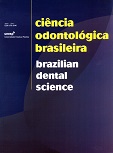Estudo in vitro da resistência ao cisalhamento de sistema adesivo após o uso do laser de Er:Yag na dentina bovina
DOI:
https://doi.org/10.14295/bds.2004.v7i2.490Resumo
O emprego do laser de Er:Yag no preparo e condicionamento dental tem sido sugerido, entretanto, o efeito dasua utilização na odontologia restauradora apresenta alguns questionamentos, como os que se refere aos parâmetrosmais adequados para a energia a ser entregue ao substrato dental. Diante destes fatos propusemo- nos arealizar essa pesquisa com o objetivo de selecionar qual o parâmetro mais efetivo, quando se considera a potênciade 60 mJ ou 100 mJ, na resistência ao cisalhamento de sistemas adesivos associados a resina composta.Sessenta incisivos bovinos recém-extraídos foram desgastados para exposição da dentina vestibular e realizaçãodos procedimentos restauradores. As amostras foram divididas em seis grupos com dez dentes em cada grupo:G1: adesivo autocondicionante Clearfill SE Bond (Kuraray); G2: laser com 60 mJ de potência,10Hz, sistemaadesivo autocondicionante Clearfill SE Bond (Kuraray); G3: laser com 100mJ de potência e 10Hz, sistema adesivoClearfil SE Bond (Kuraray); G4: condicionamento utilizando-se ácido fosfórico à 37% mais adesivo monocomponenteSingle Bond; G5: laser com 60 mJ de potência,10Hz, condicionamento com ácido fosfórico à 37%e sistema adesivo Single Bond (3M); G6: laser com 100mJ de potência,10Hz, condicionamento com ácido fosfóricoà 37% e sistema adesivo Single Bond. Sobre a superfície de dentina foram confeccionados cilindros deresina, após 24 horas realizou-se o ensaio de resistência ao cisalhamento. Os resultados foram submetidos àanálise de variância e ao teste Tukey. Concluímos que os adesivos avaliados não apresentaram diferença estatísticaquanto a resistência ao cisalhamento e que o laser promoveu diminuição estatisticamente significante naresistência de união da resina composta à dentina.Downloads
Downloads
Publicado
Como Citar
Edição
Seção
Licença
TRANSFERÊNCIA DE DIREITOS AUTORAIS E DECLARAÇÃO DE RESPONSABILIDADE
Toda a propriedade de direitos autorais do artigo "____________________________________________________________________" é transferido do autor(es) para a CIÊNCIA ODONTOLÓGICA BRASILEIRA, no caso do trabalho ser publicado. O artigo não foi publicado em outro lugar e não foi submetido simultaneamente para publicação em outra revista.
Vimos por meio deste, atestar que trabalho é original e não apresenta dados manipulados, fraude ou plágio. Fizemos contribuição científica significativa para o estudo e estamos cientes dos dados apresentados e de acordo com a versão final do artigo. Assumimos total responsabilidade pelos aspectos éticos do estudo.
Este texto deve ser impresso e assinado por todos os autores. A versão digitalizada deverá ser apresentada como arquivo suplementar durante o processo de submissão.




























